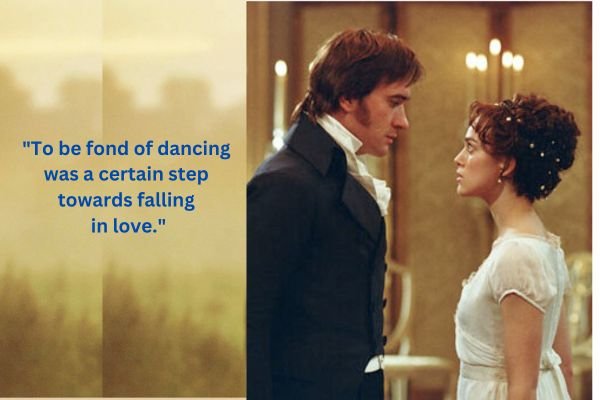Characters In Pride and Prejudice
Jane Austen’s “Pride and Prejudice” is celebrated as a timeless masterpiece in English literature, cherished for its rich characters and enduring themes. At the center of this literary gem is Elizabeth Bennet, a determined and discerning young woman navigating the complexities of early 19th-century English society. Through Austen’s skillful storytelling, Elizabeth’s journey unfolds with depth and insight, offering readers a captivating exploration of wit, romance, and societal norms. Indeed, “Pride and Prejudice” transcends its era, resonating with audiences across generations and solidifying its place as a cherished classic.

In a society fixated on marriage, class, and social expectations, Elizabeth, the second of the five daughters in the Bennet family, is a breath of new air. Her voyage becomes a symbol of the novel’s examination of pride, prejudice, and the complexity of love. Her humour and independent spirit put her apart from her contemporaries, making her a compelling protagonist.
Elizabeth is surrounded by the numerous Bennet family members, each of whom adds a distinct flavour to the story. The father of the family, Mr. Bennet, injects humour and sarcasm to provide lighthearted relief amidst the social drama.
Mrs. Bennet adds humour and drama to the narrative because of her strong desire to see her daughters get married.
The entrance of Mr. Bingley, a charming and well-to-do bachelor, and his mysterious companion, Mr. Darcy, ushers in the love scene. Elizabeth’s older sister Jane Bennet falls in love with Mr. Bingley’s charm, but Elizabeth immediately despises Mr. Darcy for his cold-bloodedness. The relationship between Elizabeth and Mr. Darcy becomes the main focus of the book, representing the themes of prejudice and pride that run throughout the story.
The background people in “Pride and Prejudice” add even more depth to the story. The obedient clergyman Mr. Collins adds a satirical aspect with his silliness and social awkwardness. The youngest Bennet sister, Lydia, adds to the family’s difficulties with her carelessness and joy. The social landscape is further complicated by the addition of other characters, such as the cunning Lady Catherine de Bourgh and the sane Charlotte Lucas.
Austen’s skill as a storyteller is demonstrated by the depth and complexity she gives each character. The protagonists experience substantial character growth, defying both social conventions and their own preconceptions as they transition from the endearing Mr. Bingley to the initially misinterpreted Mr. Darcy. The clever observations and societal commentary interwoven into character interactions, in addition to the romantic entanglements, are what make this story so charming.
Misunderstandings, discoveries, and character development drive the protagonists towards a satisfactory conclusion as the story progresses. Austen demonstrates her acute insight of human nature through Elizabeth’s path from early judgements to self-awareness and Mr. Darcy’s metamorphosis from aloofness to vulnerability.
“Pride and Prejudice” is really a complex examination of the human condition within the confines of a society preoccupied with marriage, class, and reputation rather than just a love tale. The characters created by Jane Austen are vivid and compelling, striking a chord with readers of all ages and encouraging them to consider the ageless themes of love, social expectations, and the never-ending quest for authenticity.
In Austen’s world of “Pride and Prejudice,” characters become more than just fictional people; they become travelling companions who leave a lasting impression on anybody who dares to immerse themselves in her enthralling story.
Summary
“Pride and Prejudice” by Jane Austen is a literary masterpiece set against the backdrop of early 19th-century English society. At its core is the story of Elizabeth Bennet, a spirited and intelligent young woman whose journey becomes a lens through which the novel explores themes of love, societal expectations, and the intricacies of human relationships.
The narrative opens with the Bennet family, led by Mr. and Mrs. Bennet, residing in the picturesque Hertfordshire countryside. Mr. Bennet’s wit and sarcasm add humor to the family dynamic, which includes five daughters: the charming Jane, the intelligent Elizabeth, the bookish Mary, the frivolous Kitty, and the vivacious Lydia.
The Bennet family faces a common dilemma of the time—the lack of a male heir to inherit their estate. With societal norms dictating that the estate can only pass to a male relative, the Bennet daughters confront the prospect of financial instability and social decline. Mrs. Bennet, aware of these challenges, is dedicated to securing advantageous marriages for her daughters, setting the stage for romantic entanglements.
The arrival of the eligible bachelor Mr. Bingley in the neighborhood initiates the unfolding drama. His amiable nature and substantial fortune attract attention, especially from Mrs. Bennet, who envisions a match between Mr. Bingley and Jane. This sets the tone for a story that skillfully explores social class, reputation, and genuine affection.
Accompanying Mr. Bingley is his close friend, Mr. Darcy, whose initial impression as a proud aristocrat becomes a central theme. Elizabeth, with her wit and independent spirit, forms a quick and unfavorable judgment of Mr. Darcy. However, as the narrative progresses, the layers of his character unravel, challenging both Elizabeth’s and the reader’s initial perceptions.
Simultaneously, Jane’s affection for Mr. Bingley encounters obstacles, fueled by Mr. Darcy’s disapproval of the match. The novel interweaves the romantic struggles of the Bennet sisters, creating a rich tapestry of love, misunderstandings, and societal expectations.
A pivotal moment occurs when Elizabeth tours Mr. Darcy’s estate, Pemberley. The grandeur of Pemberley and accounts of Mr. Darcy’s benevolence force Elizabeth to reassess her assumptions. This segment underscores Austen’s exploration of societal norms and the influence of personal growth on relationships.
The plot thickens with the elopement of Lydia Bennet and Mr. Wickham, a charming officer with a dubious reputation. The scandal threatens the Bennet family’s reputation, becoming a turning point that highlights the consequences of societal expectations and personal choices.
As the narrative approaches its climax, misunderstandings are clarified, characters confront their prejudices, and the transformative power of love takes center stage. The union of Elizabeth and Mr. Darcy symbolizes a triumph over societal norms.
Austen’s prose, marked by wit and keen observations, elevates “Pride and Prejudice” beyond a simple romance novel. The characters come alive, inviting readers to witness their romantic endeavors and reflect on the timeless themes embedded in the narrative.
In conclusion, “Pride and Prejudice” is a testament to Austen’s narrative prowess. Through Elizabeth Bennet’s journey, readers explore human relationships, societal expectations, and the enduring quest for authentic love. The novel’s enduring popularity lies in its ability to resonate across generations, offering insight into human nature and the timeless pursuit of happiness.
Read Also : Poetry

I am Literature student…. Well explained… nice summary